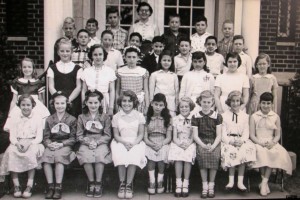The sturdy old wood-topped desks in the grammar school I attended had holes in the upper-right-hand corner where inkwells used to be. These round empty spaces fascinated me as much as whatever my teacher happened to be writing on the blackboard. I wondered what color the ink had been, what those old-time students were like. Did the boys wear britches? Were the girls named Sarah or Adelaide? Did the teacher smack the kids with a ruler if they spilled some ink on the floor?
We modern, post-war boomer babies didn’t need inkwells because we had ballpoint pens (and pencils and crayons) at our easy disposal. Nevertheless, that empty space on my desk drew me in. I wanted to know the stories the ink in that once-wet inkwell had once produced. Were those stories much different from my own? Do we all have inkwells – real or imagined – from which we draw our deepest stories?
My parents had moved to this middle-class town in northern New Jersey because of its good schools. This grammar school, an immense (it appeared to me at the time) red-brick structure, seemed to have been there forever and could withstand whatever bombs — for which we regularly practiced air-raid drills — might strike it. I loved it. It was my haven.
What little diversity the town offered was in terms of religion. Some of us kids went to Bible class one afternoon after school every week, others went to Catholic catechism class, others to Hebrew school. Yet I sensed no divisiveness; we were just one big class.

One of my friends who went to Hebrew school was Jeff Newman, a super-bright, earnest boy who was in almost every one of my classes from grammar school through to high school graduation. In fact, Jeff and I attended our 50th high school graduation celebration together in October 2013. I knew then that Jeff was ill, suffering from chronic leukemia and a rare blood disorder that turned his fingernails ink-blue, but no one at the reunion seemed to notice. Jeff was buoyant and stoic; he hid his illness well.
Last week I received a phone call from Jeff’s younger brother telling me that Jeff had just died and asking me whether I would care to write something for the memory book he was putting together.
I went to the inkwell in my heart and pulled up this:
Of all my former schoolmates, Jeff was the one I saw most regularly over the years. We both lived in New York. We both had our own businesses in the City – he a law firm and I a catering company. We met for lunch now and then.
I’d take the subway from my apartment on the Upper West Side — near Columbia, which both Jeff and I had attended many years before — down to SoHo, where Jeff’s sunny, art-gallery-cum-law office was. He’d greet me with a bear hug and a big grin, and then we’d find a quiet little place close by where we could eat and catch up.
Jeff was my friend, my lawyer, and my one-and-only rabbi. He had, it seemed to Protestant me, a rather somber, rabbinical air about him at times. His views and pronouncements seemed to come from on high (Mount Olympus? Mount Sinai?). I sometimes wanted to chide him, “Come down to earth, Jeff dear,” but I didn’t. He was on another plane.
Jeff was good to me. And kind. We could talk. He listened (from on high). I will miss him. But I know his spirit lives on in a place where we’ll all meet and catch up again one day. Until then, I’ll keep replaying Jeff’s classic parting words to me, “Be well, Bonnie,” and I’ll try my best to follow this wise counsel.
I live in Taos, New Mexico, now, where I teach workshops in Creative Nonfiction writing. My students, mostly retired professionals – doctors, lawyers, pilots, photographers, psychologists, professors – have begun to dip into inkwells they didn’t know they had to write true stories about their lives and the lives of their loved-ones that only they can write. I know the color of their ink. It’s a dazzling, crystal-clear blue.
